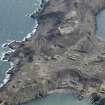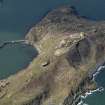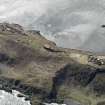Following the launch of trove.scot in February 2025 we are now planning the retiral of some of our webservices. Canmore will be switched off on 24th June 2025. Information about the closure can be found on the HES website: Retiral of HES web services | Historic Environment Scotland
Forth Defences, Outer, Inchkeith, "l" Group (Later "h" Group), 9.2-inch Gun Emplacement
Coastal Battery (20th Century), Coastal Battery (Second World War), Coastal Battery (First World War)
Site Name Forth Defences, Outer, Inchkeith, "l" Group (Later "h" Group), 9.2-inch Gun Emplacement
Classification Coastal Battery (20th Century), Coastal Battery (Second World War), Coastal Battery (First World War)
Alternative Name(s) The Cawcans; North Battery
Canmore ID 122972
Site Number NT28SE 5.05
NGR NT 29277 82945
Datum OSGB36 - NGR
Permalink http://canmore.org.uk/site/122972
- Council Fife
- Parish Kinghorn
- Former Region Fife
- Former District Kirkcaldy
- Former County Fife
SUMMARY RECORD
"Three 9.2-inch guns formed the main armament of Inchkeith. This calibre of gun was intended to tackle the largest enemy ships that might attack the British coast. The guns were mounted in separate emplacements set along the high central ridge of the island: that originally known as “L” Group was the northernmost, to the north of the lighthouse. The emplacement was originally built in 1893-5 to hold a 4.7-inch Quick Firing gun. The 4.7-inch gun was removed in June 1903 and replaced by the 9.2-inch gun in 1904. The three 9.2-inch guns formed the only heavy armament of the island on the outbreak of the First World War, prior to the reinstatement of the 6-inch guns. [WO 192/251]
By February 1918 what had hitherto been called “L” Group was re-named “H” Group [WO 192/251]. By 1938 the gun’s name had changed again, to “North 9.2” gun”.
The emplacement was originally open but a canopy of brick and concrete with steel supporting beams was added prior to or in the early stages of the Second World War, to provide protection from air attack.
NT28SE 5.05 29277 82945
This battery is annotated on a plan of the island (PRO 192/251), as containing a 9.2" calibre gun and is situated immediately N of the lighthouse (NT28SE 6).
Information from RCAHMS (DE) November 1997.
The third large 9.2-inch gun emplacement of three on the Island, on the central ridge, but on a small plateau, N of the lighthouse (NT28SE 6.00).
The single emplacement for a 9.2-inch gun consists of a concrete gun pit, brick and concrete canopy all set over extensive underground magazines, offices and rooms.
The below ground installation is entered through a small courtyard S of the emplacement and via a rock cut trench, which is cut from W of the site. A suit of rooms on all sides of the courtyard, some having been cut into and from the rock at the S end. The entrance to the magazines on the N side.The remains of a metal stair leads to the gun emplacement immediately to the N..
Below ground is a brick lined corridor leading to the magazines with a shell hoist for the large calibre ammunition positioned about half way along.
Within the circular gun pit are several ready-use ammunition lockers and a moveable 'bridge' provides access to the rear of the gun emplacement. A large cable trench runs across the floor of the gun pit and a series of large metal rings are set around the wall of the gun pit, installed to assist in the servicing of the guns allowing them to be jack hoisted into position using the rings to provide stablising points.
The emplacement when built was likely to have been an open mounting with no canopy and it is likely that the brick and concrete canopy with steel supporting beams was added either immediately before World War II or in late 1939-early 1940. The gun emplacement is annotated as 'L Group' on the War Office plan of the Island (copy held in RCAHMS under MS 879/83).
Visited by RCAHMS (DE, AL, JM), 25 February, 3 and 5th March 2009
Project (March 2013 - September 2013)
A project to characterise the quantity and quality of the Scottish resource of known surviving remains of the First World War. Carried out in partnership between Historic Scotland and RCAHMS.








































































































































